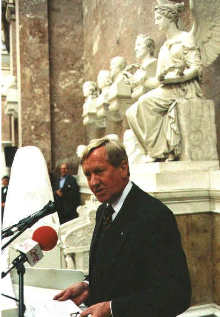"Only the Lord's gaze penetrates the future."
Mother Teresa of Jesus Gerhardinger


Life and Legacy of Carolina Gerhardinger
Carolina Gerhardinger was born on June 20, 1797 in Regensburg-Stadtamhof, the daughter of ship captain Willibald Gerhardinger and his wife Francisca. She attended the Canons of Notre Dame school in Stadtamhof until it closed in 1809 as a result of secularization.
At the age of 12, Carolina trained as an assistant teacher along with two other girls. At the age of 15, she successfully passed the exam to become a "Royal Bavarian Teacher".
When Bishop Wittmann died that same year, Carolina Gerhardinger found support in Fr. Francis Sebastian Job, a friend of Bishop Wittmann and confessor of Empress Carolina Augusta of Austria. With this unexpected death in 1834, the foundation of the convent was once again called into question. On November 16, 1835, Carolina made her profession of vows in the Chapel of St. Gall in Regensburg and took the name Maria Teresa of Jesus.
His apostolic concern was to provide girls from humble backgrounds with a solid education and religious formation and thus contribute to the Christian formation of the family and the improvement of society. The young monastic community expanded rapidly. In 1839 it opened a branch in the Au district of Munich. Maria Teresa de Jesus Gerhardinger considered it necessary to build a centrally located motherhouse that would also serve as a formation center for the young sisters.
With the support of King Ludwig I, she was given the empty monastery of the Poor Clares at the Anger in Munich. From October 16, 1843, the new motherhouse in Munich was the place where the young sisters were introduced to religious life and received scientific and practical training as teachers. From here, they went wherever new branches could be founded.
At the request of King Ludwig, Maria Teresa of Jesus Gerhardinger left for North America with five young sisters in 1847, where she founded eight new branches in one year and appointed 26-year-old Carolina Friess as vicar general on the American continent, i.e. as her deputy, to administer the new mission. After her return from America, Maria Teresa de Jesus Gerhardinger received many requests for school sisters to settle in other parts of Germany and in other European countries.
The Congregation experienced setbacks during the wars in Europe. The struggle for recognition of the structure of the order's government, which provided for central leadership by a woman, and the associated dispute with Karl August Graf von Reisach, archbishop of Munich and Freising, had a happy ending in 1865, when Pope Pius IX approved the rule according to Me Teresa's request. This was the first time that the central leadership of a community with a woman as superior general had been approved.
Maria Teresa of Jesus Gerhardinger died on May 9, 1879 at the Angerkloster in Munich and has her tomb in the Church of St. Jakob (James). When she died, there were already more than 3,000 sisters, 200 communities of sisters in Europe and the United States, and 80,000 children and young people in orphanages, kindergartens and schools.
The road to Mother Teresa's beatification
On November 17, 1985, Teresa of Jesus Gerhardinger was beatified by Pope John Paul II in Rome. The impetus for the beatification came from the German Catholic Women's Association in 1925. The miracle of the beatification took place in Brazil, when a sister called Tecla de Medeiros was cured of cancer.
Her strength of faith, her trust in God and her love for God and neighbor were particularly recognized. Many people pray at the Foundress' tomb in St. James' Church, Munich, entrusting their needs and thanks to the book of intercession that has been displayed.

In honor of Blessed Maria Teresa de Jesus Gerhardinger, we hold a religious service at St. James' Church, Munich in Anger, on the 9th of every month at 5pm. It is commemorated on May 9 (the day of her death) and November 17 (the day of her beatification).
Download Pope John Paul II's homily on the occasion of the Beatification of Mother Teresa of Jesus Gerhardinger.
Pioneer in education: recognition at Walhalla
On September 3, 1998, Blessed Maria Teresa de Jesus Gerhardinger's achievements as a pioneer in women's education in Bavaria were honored with the installation of a bust in the Walhalla.
According to the Minister of Education, Hans Zehetmair, in his speech, Me. Teresa made a decisive contribution to improving the living and educational situation of women and girls. There were advanced training schools and separate secondary schools for girls who had dropped out of school. She pioneered today's types of school: primary and secondary schools. She placed particular emphasis on musical education and other arts. Blessed Maria Teresa de Jesus Gerhardinger also made a qualified contribution to continuing education for girls who had completed elementary school. Another major contribution was qualified training for convent teachers, i.e. from their schools. Based on the concepts of Pestalozzi and Fröbel, she shaped early childhood education in Bavaria; she set up "soup schools" for poor children and offered them care outside of school hours. She founded technical schools with the aim of promoting family sustainability. She also laid new foundations for family education. She was a pioneer and a great defender of women's rights and the fight for human dignity.
According to the Minister of Education, Hans Zehetmair, in his speech, Me. Teresa made a decisive contribution to improving the living and educational situation of women and girls. There were advanced training schools and separate secondary schools for girls who had dropped out of school. She pioneered today's types of school: primary and secondary schools. She placed particular emphasis on musical education and other arts. Blessed Maria Teresa de Jesus Gerhardinger also made a qualified contribution to continuing education for girls who had completed elementary school. Another major contribution was qualified training for convent teachers, i.e. from their schools. Based on the concepts of Pestalozzi and Fröbel, she shaped early childhood education in Bavaria; she set up "soup schools" for poor children and offered them care outside of school hours. She founded technical schools with the aim of promoting family sustainability. She also laid new foundations for family education. She was a pioneer and a great defender of women's rights and the fight for human dignity.
The Deputy Prime Minister of Bavaria and Bavarian Minister of State for Education, Culture, Science and Art, Hans Zehetmair, honored the occasion of the installation of the bust of Blessed Sister Maria Teresa de Jesus Gerhardinger in the Walhalla on September 3, 1998, at 11am.

The Minister's speech: Who was this woman - Carolina, Maria Teresa de Jesus Gerhardinger?
Carolina Gerhardinger (1797 - 1879) became a "royal teacher" in her hometown of Stadtamhof, near Regensburg, at the age of 15 she began her vocational process which led to the founding of the Congregation of the School Sisters of Notre Dame at the age of 36; she died at the age of 82 in the Angerkloster in Munich and was beatified in 1985. Strong in faith, farsighted and courageous, she responded to the needs of her time, especially those of women and girls in the poorest areas, creating educational opportunities for them through personal commitment and the service of like-minded women, thus improving their quality of life in the family and in society. This initially happened at home, but quickly became a decisive factor in shaping the education and school system far beyond Bavaria.
Curiosities about Walhalla
King Ludwig I of Bavaria built the Walhalla in Donaustauf, near Regensburg, between 1830 and 1842, so that famous "German-speaking" personalities, whose work has lasting significance, could be immortalized in it with a plaque bearing their name or a marble bust. There have been 187 people in Walhalla so far. Maria Teresa de Jesus Gerhardinger is now the tenth woman, and at the same time, the first to enter the temple of glory since the king's death.
It is the right of the Bavarian state government to select the personalities for Walhalla. In this case, the Bavarian Academy of Sciences received around 60 suggestions for names with reasons. On March 10, 1998, the Bavarian Council of Ministers took the decision to admit Carolina, Sister Maria Teresa de Jesus Gerhardinger, to Walhalla.
The speeches of September 3, 1998 gave the following reasons, among others: What Maria Teresa Gerhardinger did was extremely important not only for the many children and young people to whom she dedicated herself, but also for the state. Her work made a decisive contribution to improving the living and educational situation of women and girls. Yes, one could describe Sister Maria Teresa as an important defender of women's rights and human dignity in our area.
Minister of Culture, Hans Zehetmair
Around 450 participants accepted the invitation to Walhalla: 190 school sisters and 260 state and church representatives, authorities and communities, officials, friends, children and young people. The ceremony with the unveiling of the bust - the work of Professor Wilhelm Uhlig, Nuremberg - and musical accompaniment by the Schütz choir and brass ensemble from Regensburg, as well as the subsequent state reception, conveyed an atmosphere of joy and mutual strengthening in service to the people. The whole celebration on the occasion of the admission of the bust of Mother Teresa, made of white Lasa marble in the Walhalla, was a confirmation of the timeliness of her commitment to the holistic development of people - so that the lives of individuals and society are better.